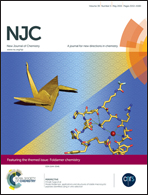Synthesis of polymeric dyes based on waterborne polyurethane for improved color stability
Abstract
A waterborne polyurethane covalently bonded anthraquinone dye chromophore was successfully synthesized via incorporating micromolecule Disperse Red 91 into the polyurethane skeleton. The number- and weight-average molecular weights of the waterborne polyurethane based polymeric dye were about 6.57k and 10.3k, respectively. The maximum absorption wavelengths are 260 nm, 520 nm and 555 nm, which show a hypsochromic effect compared with the corresponding micromolecule dye. Thermal stability and centrifugal stability can be distinctly enhanced after the micromolecule dyes are covalently bonded to the polyurethane skeleton. The solubility of waterborne polyurethane based polymeric dye also offers reversibility and good color stability at different pH values. Thermal migration properties of this polymeric dye are improved by 82.4%, compared to that of a simple mixture of dye and polyurethane. The polymeric dye with enhanced color stability under centrifugation, acid, alkaline and thermal conditions can upgrade the product quality as it is employed in dyeing, coating or printing ink.


 Please wait while we load your content...
Please wait while we load your content...